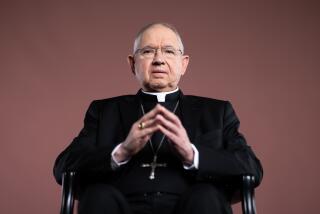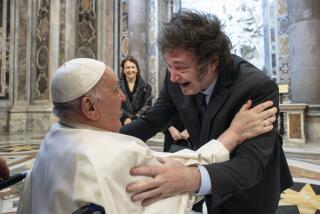Pope Blesses Juan Diego, Mary’s Messenger : Catholicism: In a beatification ceremony, the pontiff reconfirms reverence for the 16th-Century Indian peasant at the Shrine of Our Lady of Guadalupe.
- Share via
The religious highlight of the opening day of Pope John Paul II’s current visit to Mexico was a ceremony confirming centuries of reverence for Juan Diego, a 16th-Century Indian peasant, as Mary’s messenger. Juan Diego and four other Mexican Catholics were beatified Sunday at the National Shrine of Our Lady of Guadalupe on the outskirts of Mexico City.
When Juan Diego, said to be one of the first converts to Catholicism in the New World, brought roses to a disbelieving Spanish bishop at the Madonna’s instruction, as the story goes, her image appeared to be stamped on the serape , or blanket, in which Juan Diego wrapped them.
She became known as Nuestra Senora de Guadalupe, the patron of Latin America, and Dec. 12 was established as the feast day for major Marian celebrations among Catholics of Mexican descent. Large observances are held at that time each year in the Archdiocese of Los Angeles as well as the Orange, San Bernardino and San Diego dioceses. All have large Latino populations.
Some Mexican historians doubt that Juan Diego ever lived. But he was clearly the star of Sunday’s beatification ceremonies at Guadalupe, where each day thousands of the faithful from around the world visit the shrine. Many crawl on their hands and knees to the front of the church where the image-bearing cloak is encased beside the altar.
The current basilica, built in 1976, can accommodate 10,000 people and is regarded as the most revered Catholic shrine of devotion and pilgrimage in the Western Hemisphere.
In early April, top Mexican bishops said at a press conference that it was virtually certain that John Paul would canonize Diego, bypassing the usual intermediate step of beatification that precedes Roman Catholic sainthood.
But the Pope instead chose to name him “blessed” on April 9 at the Vatican. Vatican press spokesman Joaquin Navarro-Valls said the delay between the official designation and the ceremony was because, in rare cases, the church may simple recognize that generations of Catholics in good faith have established a “cult” surrounding a person. When this happens, the recognition is an automatic beatification, he explained.
Normally, beatification requires the church to certify through investigation that a person died a martyr or that a miracle attributed to the person’s intercessory prayers occurred after his or her death.
Beatification means that a person can have a feast day on local liturgical calendars in places where he or she is venerated.
In the same May 6 ceremony, John Paul beatified three Indian boys, Cristobal, Antonio and Juan, who are among the first New World Christians martyred for their faith in the 16th Century, as well as a 19th-Century Mexican priest, Jose Maria de Yermo y Parres, whom the Pope praised as “the apostle of charity.”
“While many people know that Juan Diego was the Indian to whom Holy Mary of Guadalupe appeared in 1531, they know little else about him beyond the fact that he took miraculous flowers to the bishops and the image of the Virgin Mary was miraculously imprinted on his . . . cloak,” said Catholic historian Janet Barber.
Mary is said to have appeared four times to Juan Diego on Tepeyac Hill, instructing him to build a church in her honor on the site.
The first church was built two years later, and church authorities claimed that more than 8 million natives were baptized into the new faith between 1531 and 1538.
The golden brooch worn by Mary in the image has a black cross similar to the one that was on the banner of Hernando Cortes--which was understood to mean that the Indians were to embrace their conquerors’ religion.
To date, Mexico’s only saint is St. Philip of Jesus, a 16th-Century Mexican Franciscan who was martyred while serving as a missionary in Japan.
This is John Paul’s 47th trip abroad since he was elected Pope in 1978 and his second to Mexico. He is scheduled to travel to 11 cities during his eight-day visit.
More to Read
Sign up for Essential California
The most important California stories and recommendations in your inbox every morning.
You may occasionally receive promotional content from the Los Angeles Times.













